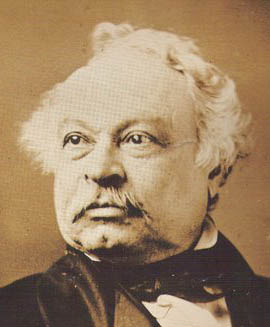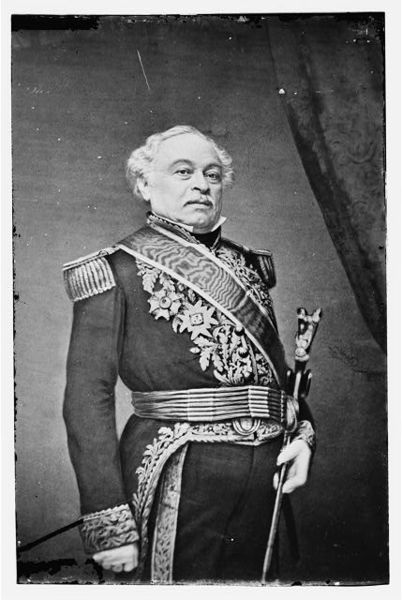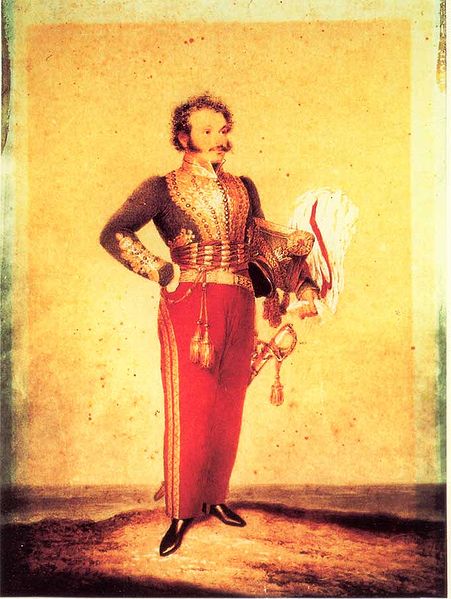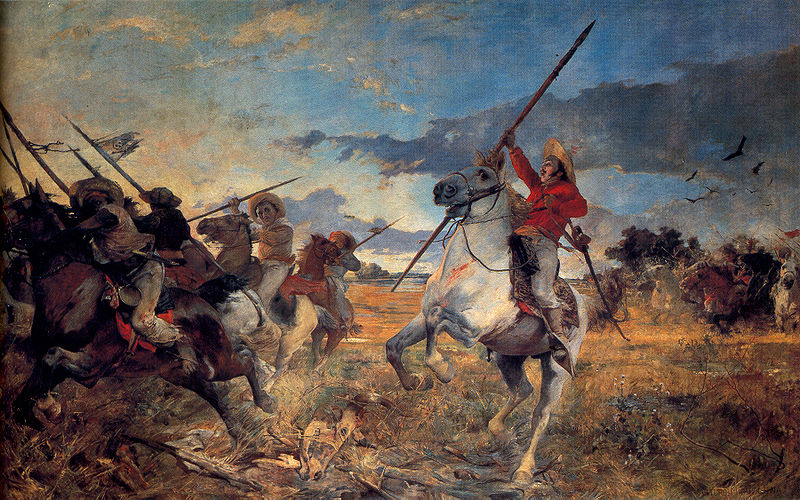<Back to Index>
- Statistician William Sealy Gosset (Student), 1876
- Writer Frances Burney (Madame d'Arblay), 1752
- President of Venezuela José Antonio Páez, 1790
PAGE SPONSOR



José Antonio Páez (13 June 1790 – 6 May 1873) was General in Chief of the army fighting Spain during the Venezuelan Wars of Independence, in addition to becoming the President of Venezuela once it was independent of the Gran Colombia (1830 – 1835; 1839 – 1843; 1861–1863). He is considered a prime example of a 19th century South American caudillo.
Páez was born in Curpa, Portuguesa State, in Venezuela. His paternal grandmother, Luisa Antonia de Mendoza and Mota, was daughter of Luís Rodríguez de Mendoza, a native of Icod de los Vinos, Tenerife (Canary Island). He was of humble origins, his father being a low level employee of the colonial government. As a boy he was forced to work like a slave. By the age of 20, his father already died, Páez was married and earning a living by trading cattle.
Late
in 1810, he joined a cavalry squadron, led by a former employer, set up
with the purpose of fighting the colonial government. In 1813, he asked
for leave from his squadron with the intent of setting and leading his
own, which he did, joining the Western Republican Army with the rank of
sergeant. Páez had an ingratiating personality which made him
very much liked amongst those who knew him. He was also looked up to
for his skills as a horseman and for his physical capabilities.
Páez, a soldier at heart, started moving up the ranks by winning year after year several engagements against the royalists with his band of marauding llaneros (plainsmen). He came to be known by the nicknames of "El Centauro de los Llanos" (The Centaur of the Plains), and "El León de Payara" (The Lion of Payara) or The Lion of Apure.
Páez had been leading the fighting in the plains while Simón Bolívar was busy with the eastern part of the country. Early in 1818, both men met to discuss better coordination of their efforts. After shortly fighting in the center of the country, Páez was ordered to go back to the western plains, where he took from the Spanish the city of San Fernando in Apure.
Páez won all of six major battles that he led by himself, the most celebrated one being the Battle of Las Queseras del Medio.
Late in 1820, an armistice had been signed with the Spanish commander and a temporary suspension of hostilities had taken place. However, ongoing developments were making difficult to maintain the armistice and, consequently, it was agreed it would lapse on 28 April 1821.
All five major fighting groups of the Venezuelan army were to start moving towards a central area. Some with the purpose of joining together in one single group and others with the intention of guarding the approach to that region to prevent royalists units from other far away areas from converging and reinforcing the main Spanish army stationed in the same area.
In early June 1821, the 6,500 men republican army was divided and organized in three divisions. The 1st division, made up of 2,500 men, was under Páez's command and formed by two battalions: Bravos de Apure (Apure Braves) and Cazadores Britanicos (British Hunters or as more often translated to English, the British Legion) and seven cavalry regiments.
By 20 June, all three republican divisions converged from different directions in the plain of Carabobo. With the royalists well entrenched in the center and the south, on the morning of 21 June, Páez was given command of an additional cavalry regiment and ordered to take it together with his own division through the hills on the north side and into the plain and to engage the Spanish, while the 2nd division would stay behind Páez and the 3rd would remain in a defensive position waiting to engage the enemy in the center.
On seeing Páez's men move, the Spanish commander, Miguel de la Torre, ordered one of his elite battalions, the Burgos, to reinforce and defend the north flank. Initially, the Spanish so fiercely engaged the Bravos de Apure battalion that it had to fall back on two occasions. Páez sent his Cazadores Britanicos to help the Bravos and together they fought back the Spanish, now reinforced themselves by two additional battalions. As the fighting intensified, de la Torre sent more troops to the north. Páez then sent his cavalry further north to outflank the Spanish and come down on the plain from behind. At this moment, the battle was obviously going against the Spanish, who in desperation kept sending reinforcements. In the meantime, Páez's men were gaining terrain and closing on the falling Spanish from all sides. Some of the Spanish battalions supposed to join and reinforce the engagement in the north, on seeing how their comrades were faring, decided to disobey orders and retreat. As it became evident that the republicans were winning the battle, the other divisions moved forward, but by now the bulk of the work had already been done by Páez and his men.
With the Battle of Carabobo, the military fate of the Spanish army in Venezuela was sealed. The victory was carried by Páez. Bolívar promoted him on site to General in Chief of the republican army.
In the battle, the Spanish lost over 65% of their men; the survivors took refuge in the castle of Puerto Cabello, which, until it was taken by Páez and his men in 1823, was the last Spanish stronghold in Venezuelan territory.
Following the Battle of Carabobo, Páez was named General Commander of the provinces of Caracas and Barinas (at the time they included the important regions of Caracas, Barquisimeto, Barinas and Apure).
It had been Bolivar's dream to unite the liberated Spanish provinces into a single great country: La Gran Colombia. It was made up of present day Colombia, Venezuela, Ecuador, and Panama. As the war against Spain came to an end, federalist and regionalist sentiments began to arise once again.
While Bolívar was engaged in military campaigns in Peru,
he was unable to carry on his duties as president of Gran Colombia. As
a result, the center of power of the executive branch was in
Bogotá under the leadership of Vice President Francisco de Paula Santander, from New Granada (modern day Colombia and Panama).
While some leaders saw Gran Colombia as only a military necessity,
others saw it as a real administrative entity. Thus confusion arose
between the central government in Bogotá and the provinces and
the municipalities. This made Páez and some Venezuelan
politicians uncomfortable. Then in 1826, after the Congress in Santa Fe
de Bogotá under Santander found a Venezuelan hero from the
independence war guilty of assassinating the French Colonel Emanuel
Roergas Serviez in Colombia, Páez initiated and led a movement
that became known as "La Cosiata"
(a word that had never existed in Spanish language and that at the time
was made up to refer to this movement and meaning something along the
lines of "that weird thing without a name").
La Cosiata started in April 1826 as a quasi-spontaneous movement (as existing historical interpretations differ) of local politicians and personalities supporting Páez. There was pressure in favor of Páez's removal from his office by locals in Venezuela, who had accused him of abusing his authority in relation to implementing orders coming from Bogotá - orders which Páez himself allegedly did not agree much with: the forced recruitment of men for the army. The Congress in Bogotá, including several of the Venezuelans among it, received the complaints coming from Venezuela, which alleged that Páez had not properly understood the extent of his orders and had exceeded them in his implementation. Congress decided that it alone could judge Páez for his actions, and ordered him to go to Bogotá for his trial.
Páez was initially willing to go. However, the irony now dictated that some of the same local personalities that were originally unhappy with Páez for implementing Santander's orders now felt insulted for their leader's having to go to Bogotá to be tried. After a few days of uncertainty and tension in the streets, the municipality of Valencia broke with Bogotá and submitted itself to Páez as military commander. In the following days, more municipalities would follow suit, including Caracas, which had been the one that first had accused Páez. Other municipalities and local officials did not join in this change of opinion.
In July, Santander declared that Páez was in open rebellion against the central government. While all this was happening, Páez wrote to Bolívar, asking him to come back to take charge and solve the imbroglio.
While Páez and his supporters were willing to have Bolívar as supreme leader, they were reluctant to follow Santander. While they wanted changes to be made to the constitution, they initially wanted to do it under Bolívar as part of the Gran Colombia.
Bolívar, finally returned from his campaigns in the south and took command of the executive towards the end of 1826 assuming the extraordinary powers granted to him by the Congress. Conflicting letters between Santander and Bolívar, and Bolívar and Páez, created a degree of uncertainty as to what his actions would be. He finally declared a general amnesty to all those that were involved in La Cosiata, notwithstanding from then on that any disobedience of his orders would be considered a crime against the state. Páez welcomed Bolívar and accepted his authority, and Bolívar named him Supreme Civil and Military Commander of Venezuela. This action confused and disappointed both Santander in Bogotá and the few local officials in Venezuela that had not supported the La Cosiata, who found themselves being removed or transferred to other posts while those that had backed Páez remained or were subsequently promoted.
Until
La Cosiata, Páez had been mostly respected as a result of his
military successes during the war. From now on he started to be seen as
a politician with the power and the wit needed to pursue and defend any
changes, or lack thereof, made under the constitutional order.
Páez came out from La Cosiata with more power than he ever had
before.
In 1830, Páez declared Venezuela independent from Gran Colombia and became president. Although he was not the first president of Venezuela (which declared its independence from Spain in 1811 and named Cristobal Mendoza as president) he was the first head of government after the dissolution of Gran Colombia. For more than thirty years from his accession to power in 1830 to his death in 1873, Páez was the greatest figure in Venezuela and would return to rule whenever the national government failed. The government ruled by the oligarchy in the country followed the Constitution of 1830. Páez and the conservative oligarchy were conveniently allied because the oligarchy controlled a great amount of their country's wealth but was not popular with the masses whereas Páez was very much liked by the masses. The 1830s to the 1860s are thought of by historians as a golden era in Venezuela's history, in contrast to previous and future dictatorships. It must be noted however that behind the constitution stood Páez, a military caudillo and that application of the law was only possible depending on his personal prestige. But he respected the law and was not interested in personal gain as demonstrated by the common conditions in which he lived. Between 1830 - 1848 under the power of Páez and the oligarchy, the economic power of the church was broken and its dominance destroyed and from then on the conflict between church and state ceased to exist unlike in other countries in Latin America.
In 1842, Páez arranged to have the remains of Simon Bolivar repatriated from Santa Marta, Colombia, to the Liberator's hometown of Caracas. The procession was accompanied by exuberant funeral honors before Bolivar's remains were entombed in the Cathedral of Caracas.
In 1847 President José Tadeo Monagas,
who was put into power by Páez, dispersed the Congress and
proclaimed himself dictator. Páez led a rebellion against him
but was defeated by General Santiago Marińo in the 'Battle of the Araguatos', imprisoned, and eventually exiled. He was exiled from
the country in 1850 and did not return until 1858. In 1861, he became
supreme dictator and ruled only for two years before again returning to
exile. He lived in New York during his years in exile and died there in
1873. Páez served as president three times, once from 1831 – 1835,
1839 – 1842 and again from 1861 - 1863.
